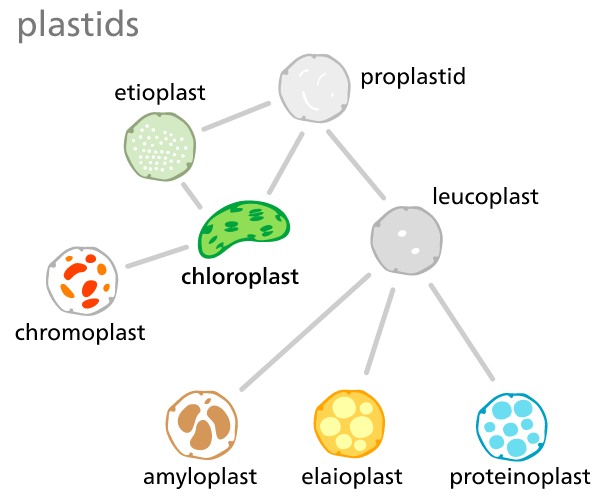
What are some functions of plastids?
Answer
379.5k+ views
Hint: Plastid is a double membraned organelle that is used to perform photosynthesis, attract pollinators, restore total leaf protein and synthesize starch along with the storage of proteins, fats, and oils.
Complete Answer:
Plastids are DNA containing double membraned structures. One type of plastid shows similarity with mitochondria. Plastids are the largest cell organelle in plant cells containing DNA, their plasma membrane is double layer like mitochondria. Plastids store a variety of substances and are classified into three types, this classification was given by Haeckel:
A) Leucoplasts: These are the largest of all plastids, they are colorless. Depending upon the components stored in leucoplasts, it's of three types:
B) Amyloplast: Carbohydrate is stored within the sort of starch.
C) Aleuroplasts: Proteins are stored here. It is also referred to as the proteinoplast.
D) Oils and fat storage occur in them.
E) Chromoplast: Coloured pigments are stored in chromoplasts. They contain carotenoids which are fat-soluble. They give color to flowers and therefore help in the attraction of pollinators and dispersers of seeds and fruits.
F) Chloroplast: It is a semi-autonomous organelle in the plant cell. It is the most photosynthetic organ in plants and thus is additionally referred to as the kitchen of the cell.

Chloroplasts may be further divided on the basis of the color of the pigment;
(a) Chloroplasts:- It contains chlorophyll and is found mainly in the cells of the leaves of higher plants.
(b) Phaeoplasts:- These are yellow or brown plastids found in brown algae, diatoms, and dinoflagellates.
(c) Rhodoplasts:- These are red colored plastids. It is found in red algae. It also absorbs light.
Additional Information regarding plastids :
The chloroplast is also a semi-autonomous cell organelle like mitochondria.
The chloroplast is semi-autonomous because it has the following two features:
a. It has its DNA, RNA, and ribosomes.
b. It also has its protein-synthesizing machinery.
Chloroplast has different shapes in different organisms. Cup-shaped, girdle shapes, spiral, stellate, reticulate, and discoidal shapes of chloroplast have been observed.
Note:
Of the three types of plastids, leucoplast, chromoplast, and chloroplast, the only chloroplast is semi-autonomous and not the others. It is believed that these semi-autonomous organelles have originated from unicellular prokaryotes during evolution.
Complete Answer:
Plastids are DNA containing double membraned structures. One type of plastid shows similarity with mitochondria. Plastids are the largest cell organelle in plant cells containing DNA, their plasma membrane is double layer like mitochondria. Plastids store a variety of substances and are classified into three types, this classification was given by Haeckel:
A) Leucoplasts: These are the largest of all plastids, they are colorless. Depending upon the components stored in leucoplasts, it's of three types:
B) Amyloplast: Carbohydrate is stored within the sort of starch.
C) Aleuroplasts: Proteins are stored here. It is also referred to as the proteinoplast.
D) Oils and fat storage occur in them.
E) Chromoplast: Coloured pigments are stored in chromoplasts. They contain carotenoids which are fat-soluble. They give color to flowers and therefore help in the attraction of pollinators and dispersers of seeds and fruits.
F) Chloroplast: It is a semi-autonomous organelle in the plant cell. It is the most photosynthetic organ in plants and thus is additionally referred to as the kitchen of the cell.

Chloroplasts may be further divided on the basis of the color of the pigment;
(a) Chloroplasts:- It contains chlorophyll and is found mainly in the cells of the leaves of higher plants.
(b) Phaeoplasts:- These are yellow or brown plastids found in brown algae, diatoms, and dinoflagellates.
(c) Rhodoplasts:- These are red colored plastids. It is found in red algae. It also absorbs light.
Additional Information regarding plastids :
The chloroplast is also a semi-autonomous cell organelle like mitochondria.
The chloroplast is semi-autonomous because it has the following two features:
a. It has its DNA, RNA, and ribosomes.
b. It also has its protein-synthesizing machinery.
Chloroplast has different shapes in different organisms. Cup-shaped, girdle shapes, spiral, stellate, reticulate, and discoidal shapes of chloroplast have been observed.
Note:
Of the three types of plastids, leucoplast, chromoplast, and chloroplast, the only chloroplast is semi-autonomous and not the others. It is believed that these semi-autonomous organelles have originated from unicellular prokaryotes during evolution.
Recently Updated Pages
The correct geometry and hybridization for XeF4 are class 11 chemistry CBSE

Water softening by Clarks process uses ACalcium bicarbonate class 11 chemistry CBSE

With reference to graphite and diamond which of the class 11 chemistry CBSE

A certain household has consumed 250 units of energy class 11 physics CBSE

The lightest metal known is A beryllium B lithium C class 11 chemistry CBSE

What is the formula mass of the iodine molecule class 11 chemistry CBSE

Trending doubts
Worlds largest producer of jute is aBangladesh bIndia class 9 social science CBSE

Distinguish between Conventional and nonconventional class 9 social science CBSE

Fill the blanks with the suitable prepositions 1 The class 9 english CBSE

What was the Treaty of Constantinople of 1832 class 9 social science CBSE

What is a legitimate government class 9 social science CBSE

Describe the 4 stages of the Unification of German class 9 social science CBSE




